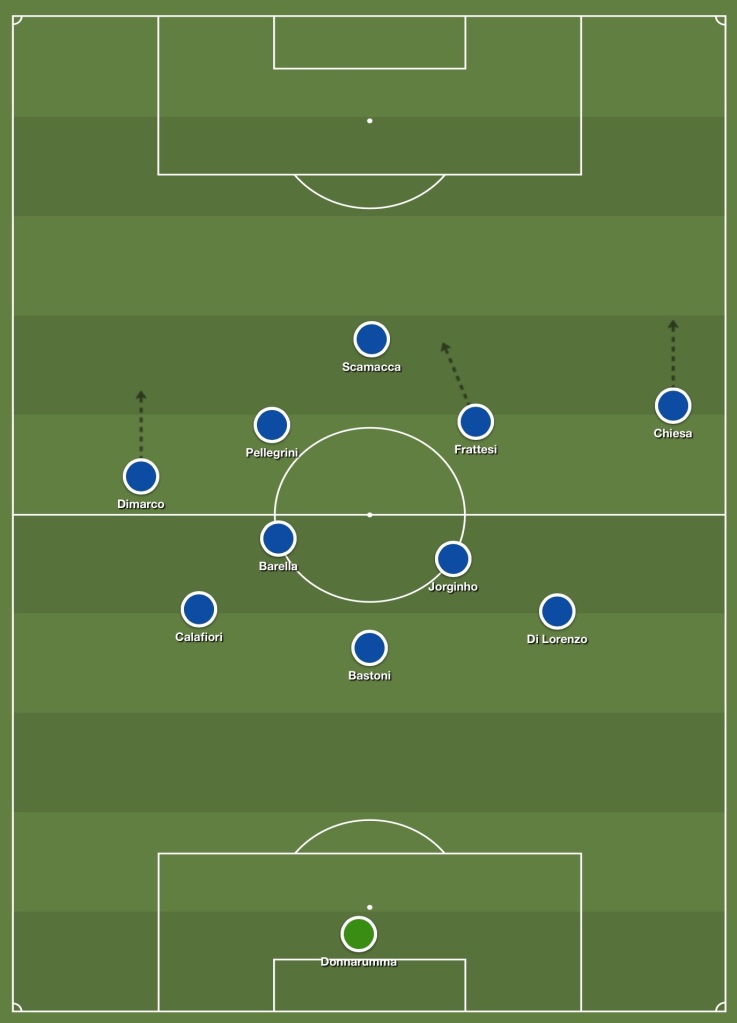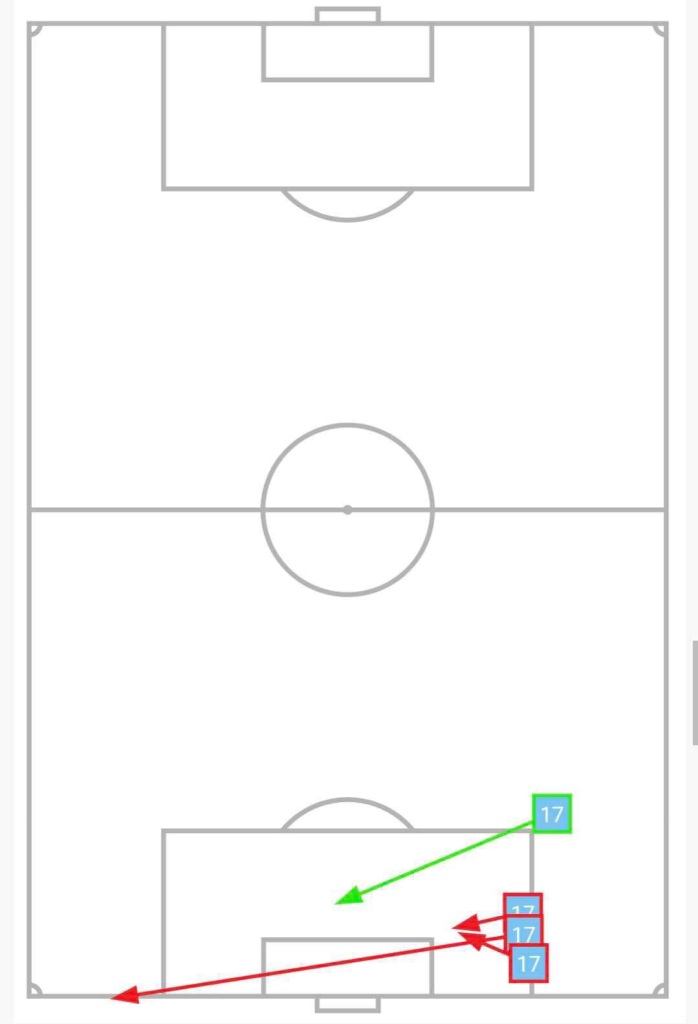Euro 2024 has the makings of a fantastic tournament. The first round of matches saw great goals, valiant displays from underdogs, and interesting things from a tactical perspective. The Conventional Playmaker is happy to be covering the Euros for the third tournament running, and will be looking at those interesting tactical themes. And for Matchday One, it was the various accounts of wing-play which set the precedent for a number of results.
Lots of teams are attacking via the their players stationed out wide. Be that their full-backs pushing forward as the nominal wingers tuck inside, be that wing-backs providing a sides main way of bringing the ball forward, or even wingers hugging the touchline like days of old.
They could be doing so because of their sides game plan, or the state of the matches have meant teams are finding more space on the flanks against compact defensive shapes. Some teams have adopted a five-man attack, some teams have deployed inverted wingers, some same foot, and some crossing heavily – with inconsistent results.
During Italy’s 2-1 win against Albania, Federico Chiesa was a constant threat on the right wing. Though going into the match, it was somewhat surprising to see Chiesa start on the right again, given how often he had been stationed on the opposite flank during qualifying matches for the tournament.
Nevertheless, Chiesa was often hugging the touchline, ready to receive a pass from midifeld, before taking on the full-back and deliver a cross. Italy created a few good attacks down the right in the first-half, after Albania, to everyone’s shock, took the quickest lead in the history of the Euros after 23 seconds.
Italy’s shape in possession was very fluid, with coach Luciano Spalletti not as keen on rigid formations. This allowed for combinations to form across the pitch, whilst the centre could be dominated, and players could rotate positions. For example, Federico Dimarco pushed forward to provide the width on the left, but also drifted centrally, and into the box, as he does for club side Inter Milan. Davide Frattesi, on loan at Inter from Sassuolo, would drift wide, and also make lateral runs ahead of Gianluca Scamacca.

The ball would be played through the centre, before sending it out wide in Albania’s half. In one instance, a cross from Chiesa was met by a run towards the post from Lorenzo Pellegrini. It was a hard run to track, and a nice in-swinging delivery which is harder for the goalkeeper to come and claim. What makes Chiesa such an effective outlet, is that he can play the ball with both feet, and can attack down the outside, or cut inside in equal measure.
More patient build-up at the start of the second-half saw the ball being sent Chiesa way, who was free, and holding the width on the right. His cross was met by Dimarco, but Dimarco mis-hit the ball. Chiesa stretched the play with his positioning, isolating the full-back, and dribbling down the outside. Yet his two-footedness meant he remained hard to predict throughout the match.
Chiesa, who completed 4 dribbles against Albania, offered a change of pace as he tricked his way past defenders meant he was hard to tackle; perhaps there was concern that could be fouled just outside or inside the box.
Poland expectedly set up in a 3-5-2, with both wing-backs, Przemyslaw Frankowski, and Nicola Zalewski, making runs down the right and left flanks, and aiming to provide crosses. But they were also tasked with tracking back against attacks down the flanks in the 2-1 defeat they suffered to The Netherlands.
Zalewski carried the ball forward and crossed the ball into the box, with one lofted, high delivery, was fired into the penalty-area, and found Jakub Kiwior on the far side, whose shot was parried by goalkeeper Bert Verbruggen. Though in return, with Xavi Simons drifting inside, Dutch attacks saw Denzel Dumfries hold the width on the right, and make runs towards the back post. Dumfries’ movement encouraged attacks be switched from one side to the other.
The battle of the wings continued on the other side. Frankwoski in particular, had a troublesome time dealing with Cody Gakpo on the left side. Gakpo would either face Frankowski one-against-one, and cut inside before shooting or combining with a teammate, or run into space on the counter-attack, and isolate the centre-back who was forced to cover for the wing-back not yet back in position.
Gakpo was very good on The Netherlands’ left, and it was Gakpo who gave the Dutch the lead, after receiving a pass from left-back Nathan Ake, before his shot from outside the box was deflected goal bound.
Ake himself would make runs down the left and play cut backs into the box to be met by one of the forwards anticipating a pass, and it was even his deflected pass that came Wout Weghorst’s way, as he struck gold, rifling the ball into the bottom corner after 83 minutes to win the match.
Jeremy Doku completed 6 dribbles in Belgium’s opening game, but those dribbles and forays to the edge of the box somehow amounted to no goals as Belgium failed to secure three points against Slovakia. Doku started on the right, with Leandro Trossard starting on the left, and Doku would dribble from deep and try to find teammates with through balls, or low crosses from the byline to the near post. Though sometimes these crosses were cleared by the Slovakia defence.
Trossard lacks the speed and directness of Doku, but would link up with teammates in shorter combinations, and wanted to receive the ball inside the penalty-area. Eventually, Johan Bakayoko, an inverted winger who plays on the right, was introduced, and this saw Doku move wide left, and Trossard occupy a central position. Belgium continued to get forward and create chances, even scoring twice, but both goals were ruled out as offside.
Portugal’s 2-1 win against the Czech Republic saw Roberto Martinez’s side dominate possession, but lacked penetration to their attacks, with few combinations in central areas against a stubborn Czech defence.
Rafael Leao was the sides main outlet, drifting wide to the left, and either drop deeper to receive and carry, or make a run down the side to meet a switch of play from deep. Leao looked to cross the ball into the box, but that method proved inconsistent, with only 1 out of 4 crosses proving accurate. But was this due to the placement of the crosses, or the lack of movement in the box from Portugal’s attacking players?

Portugal’s system, like Italy’s, was flexible and fluid, with the shape resembling a 3-5-2 or 3-4-3, depending on the positioning of Bernardo Silva and Leao. Eventually, Portugal made some substitutions, which saw more positional changes.
One of those additions was winger Pedro Neto, who proved handy. He provided an outlet on the left like Leao, but an aggression and directness that was needed in the games latter stages. And three substitutes combined for the winning goal. Diogo Jota passed to Neto, and then ventured into the penalty-area. Neto took on the defender, and played a ball towards the run from Chico Cocenciao, who swiftly finished to hand his nation a vital three points.
